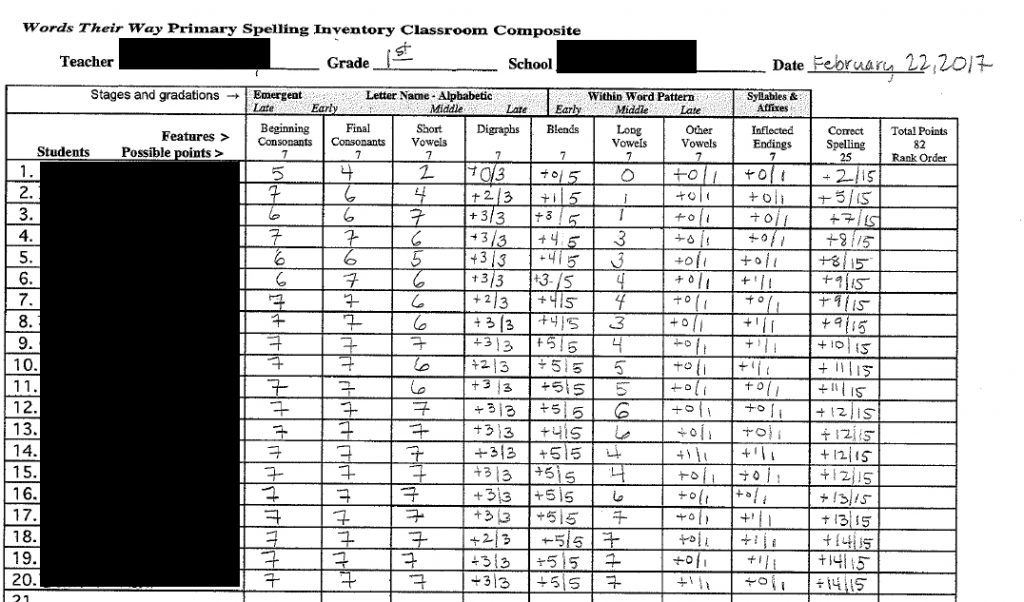Have you ever heard your car make an unknown sound? You know how that goes – you hear the sound, then you call your mechanic to get an appointment, then you describe the sound (often a bit embarrassing!), and then the mechanic uses what you told him plus what he sees and hears himself, and then he fixes your car and you are back on track.
Reading interventions are a lot like this:
- You ‘hear’ information (data) about a student’s reading.
- You use that information to figure out what that student needs.
- You plan an intervention to try to “fix” or solve that challenge.
- You check to see if the intervention worked.
For example, you have “Moses” in your class. Moses is a sweet, bright student but his spelling is very difficult to read. He struggled with the Words Their Way spelling inventory. When you look at the results, you see specifically that he struggled with short vowels, blends, and long vowel patterns. (See his results below. He is #5.)
Now that you have this information (data), you know that he needs interventions in short vowels, blends, and long vowel patterns. Start with short vowels and practice. He will need a vowel card or alphabet card so you can practice “letter a, sound /a/ like apple” and do this for all five vowels. If you help the parents learn the sounds, you can send home a copy of the vowel card for him to practice. A dry-erase board is a great place to practice dictation: you say a word, emphasizing the sounds, and he writes the word. You both check it together. You can also just practice phonemic awareness where he has nothing in front of him but you say a word and ask for the vowel (“what is the vowel sound you hear in top?”). You may also play a game where you say two words and ask for the word with the short /o/ sound. “Which word has a short /o/ sound, top or lip?”
After you have given these interventions for about four weeks, ask Moses to spell just the words on the Words Their Way inventory with short vowels. This is progress monitoring: is the intervention working? If yes, then you can move on to work on blends. If not, stick with short vowels for another four weeks.
I know what you are thinking. This all sounds great, but when do I do this? Using guided reading within a structure like reading workshop or Daily Five, you can be freed up to work with students in small groups or individually. You can see from the Words Their Way results above that Moses is not the only student struggling with short vowels. So when you pull your guided reading group for about 15 minutes, you can add a few extra minutes with the students in each group who need extra help. It is possible that Moses’ guided reading group also needs short vowel practice, so you can work on that with them, doing the activities mentioned above, with the whole group or all who need it. If students do silent reading or Read to Self during a time you are not teaching guided reading, you can pull students then. Do not pull students out of recess, physical education, art, or music.
As you observe students in guided reading and other times of day, you will gather information (data) about their reading and the progress they are making. That information can be added to your ‘data pile’ when you progress monitor.
The big key to reading interventions is documenting or recording where your students started, what interventions you provided and for how long, and then what progress they are making. This requires a bit of organization: a clipboard with a documentation like the one below, or a table in Google Docs or Word. Very often, these interventions make all of the difference and students are back on track.
NCEA invites you to the NCEA New Directions Exceptional Learners Conference on June 19-21 in Evanston, Illinois. It will be a gathering of national experts sharing theory and practice in the field of inclusion.


